Stock Market Future Bull
Stock-Markets / Stocks Bull Market Sep 25, 2014 - 06:11 PM GMTBy: John_Mauldin
 In a conversation this morning, I remarked how rapidly things change. It was less than 20 years ago that cutting-edge tech for listening to music was the cassette tape. We blew right past CDs, and now we all consume music from the cloud on our phones. Boom. Almost overnight.
In a conversation this morning, I remarked how rapidly things change. It was less than 20 years ago that cutting-edge tech for listening to music was the cassette tape. We blew right past CDs, and now we all consume music from the cloud on our phones. Boom. Almost overnight.
A lot has changed about the global economy and politics, too. Things that were unthinkable only 10 years ago now seem to be reality. What changes, I wonder, will we be writing about a few years from now that will seem obvious with the advantage of hindsight?
In today’s Outside the Box, my good friend David Hay of Evergreen Capital sends us a letter written from the perspective of a few years in the future. I find myself wishing that some of the more hopeful events he foresees will come true, and my optimistic self actually sees a way through to such an outcome. In that future, I will join David as a bull. But the path that he proposes to take to that more optimistic future is not one that most investors will enjoy, so on the whole it’s a very sobering letter and one that should make all of us think.
I’m back from San Antonio, where I spent four enjoyable days with my friends and participants at the Casey Research Summit. I tried to attend as many of the conference sessions as I could, and I intend to get the “tapes” for some of the ones I missed.
I did a lot of video interviews while in San Antonio, too. And finished up a major documentary. Mauldin Economics will be making all of these available very soon. It’s hard to recommend one interview over another, but Lacy Hunt is just so smart.
And with no further remarks let’s turn it over to David Hay and think about how the next few years will play out. Have a great week.
Your wishing his crystal ball was clearer analyst,
John Mauldin, Editor
Outside the Boxsubscribers@mauldineconomics.com
Future Bull
By David Hay
Twitter: ;@EvergreenGK
“Money amplifies our tendency to overreact, to swing from exuberance when things are going well to deep depression when they go wrong.”
– Economist and historian Niall Ferguson
Future bull. Let me admit up front that this EVA has been rolling around in my mind for quite awhile. Its genesis may be directly related to the fact that I’ve been desperately yearning to write a bullish EVA – besides on Canadian REITs or income securities that get trounced by the Fed’s utterances. In other words, I want to return to my normal posture of being bullish on the US stock market.
It wasn’t long ago, like in 2011, that clients were chastising me for believing in what I formerly referred to as “the coiled spring effect.” By this I meant that corporate earnings had been rising for over a decade, and yet, stock prices were much lower than they there were in 1999. Consequently, price/earnings ratios were compressed down to low levels, though certainly not to true bear market troughs. My belief was that stocks were poised for an upside explosion once the inhibiting factors, primarily extreme pessimism on the direction of the country, were removed. I even remember one long-time client dismissing my “Buy America” argument on the grounds that in my profession I had to be bullish (regular EVA readers know that is definitely not the case!).
Well, a funny thing happened to my “coiled spring effect” – namely, it became a reality. Additionally, the upward reaction was much stronger than I envisioned. But what really caught me by surprise was that it played out with virtually no improvement on the “extreme pessimism on the direction of the country” front. Perhaps I’m wrong, but I don’t think there has ever been a rally that has taken stocks to such high valuations (time for my usual qualifier – based on mid-cycle profit margins, not the Fed-inflated ones we have today) concurrent with such pervasive fears America is on the wrong track.
Undoubtedly, the pros among you who just read that last sentence are thinking: “That’s great news! All that pessimism will keep this market running. We’re not even close to the peak.” Not so fast, mon amis (and amies)! We’re not talking market pessimism here. As numerous EVAs have documented, US investors are as heavily exposed to stocks as they have ever been, other than during the late 1990s, when stocks bubbled up to valuations that made 1929 look restrained.
Further, please check out the chart below from still-bullish Ned Davis regarding investment advisor sentiment. The bearish reading is the lowest since the fateful year of 1987, while bulled-up views are in the excessively optimistic zone. (See Figure 1.)
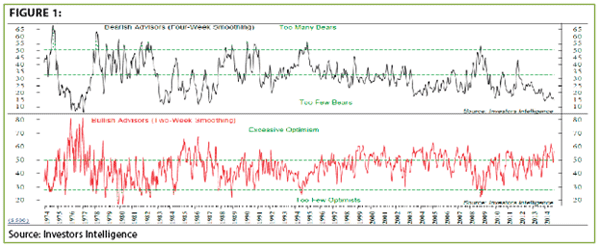
It is my contention that there are currently millions of fully-invested skeptics. They aren’t bullish long-term – in fact, they believe the underlying fundamentals are alarming (with the usual perma-bull exceptions) – but they feel compelled by the lack of competitive alternatives to remain at their full equity allocation. Disturbingly, professional investors are increasingly doing so even with money belonging to retired investors who need both cash flow and stability.
Okay, with all that history out of the way, let’s go the other direction – into the future, to a time several years from now, when conditions are nearly the polar opposite of where they are today.
The Evergreen Virtual Advisor (EVA)
November, 201???
At long last, reforms! Do you remember back in 2014 when the stock market was as hot as napalm? When it just never went down? When millions believed the Fed could control stock prices by whipping up a trillion here and a trillion there?
Looking back from the vantage of today, it all seems so obvious. We should have known better than to believe that the S&P 500 had years more of appreciation left in it after having already tripled by the fall of 2014 from the 2009 nadir. The warning signs were there. But, before we rehash what went wrong, let’s focus on the upside of what some are calling “The Great Unwind” – the hangover after years and years of the Fed recklessly driving asset prices to unsustainable heights.
First of all, let me start with what I think is the biggest positive of all: the end of the central banks’ era of omnipotence. While that might sound like a major negative, you may have noticed that with the crutch of binge-printing taken away, our nation’s leaders are finally getting around to implementing reforms that should have been enacted years ago. The history of our country is that we are energized by crises, and the latest is no exception. Our most recent financial convulsions have galvanized a bipartisan coalition to attack an array of long-festering problems that have hobbled our country since the start of the millennium.
Arguably, the most important was the recently enacted tax reform legislation. Skeptics believed the US could never move toward the type of simple tax system that has long been used in countries like Singapore, Hong Kong, and even Estonia. It took the realization by both parties that lower tax rates with almost no deductions would actually produce more revenue. Moreover, the elimination of incalculable and massive “friction costs” for millions of businesses and individuals, trying to adhere to and/or game that beastly labyrinth known as the tax code, is quickly catalyzing real economic growth. This is in contrast to the 2010 to 2014 counterfeit version that rolled off the Fed’s printing press.
By 2014, the US was ranked a lowly 32nd out of 34 countries in terms of tax fairness and efficiency. Yet, now, thanks to last year’s drastic tax reform, US corporations are no longer fleeing in droves to other countries, using such tax dodges as inversions (buying out foreign companies and assuming their country of corporate citizenship to access lower tax rates). They have even begun to repatriate their trillion or so of offshore profits since the formerly onerous tax rate of 35%, the highest in the developed world, has been reduced. And, thanks to the eradication of the aforementioned legalized tax dodges, corporate tax receipts are actually beginning to rise sharply, despite the fact that our economy is in the early stages of recovering from the latest recession.
As we all know, the rationalization of our national business model involves much more than even the essential aspect of tax code simplification. At long last, meaningful tort reform has been enacted. No longer will the rule of lawyers be allowed to dominate the rule of law. The enormous, but insidiously hidden, costs of a subsector of the legal system whose chief mission is to squeeze unjustifiable sums from the private sector is finally being reined in.
Similarly, regulatory overkill is also being addressed by the very entity that created this monster in the first place: the government itself. Absurd, overlapping, and often conflicting directives that hobbled the most essential element of the private sector – small businesses – have been abolished, replaced by a much simpler and unified set of rules.
Even America’s dysfunctional and wasteful healthcare system is being revamped using rational economic solutions, rather than by piling on more incomprehensible rules, requirements, and panels. Consumers can now easily compare prices among service providers thanks to technology as instituted by for-profit providers. Along with significantly improved visibility, they also now have far greater control over how their healthcare dollars are spent. Medical outlays are now in a decided downtrend.
Incredibly, Congress is actually beginning to behave like a representative of the people rather than an ATM dispensing taxpayer money to the most politically connected. The intense implosions of the multiple bubbles the Fed intentionally inflated triggered a backlash of voter ire toward its legislative enablers. Since then, we’ve seen a dramatic House – and Senate – cleaning. This new “coalition of the thinking” is now following the proven path to recovery that numerous countries – such as Germany, Sweden, and Canada – blazed when their economic and financial systems hit previous roadblocks. As in those nations, moving away from excessive socialism, while simultaneously supporting the business community, rather than vilifying and hindering it, is already beginning to elevate America out of its long stagnation.
Collectively, these sweeping reforms are as dramatic as those seen in the 1980s and promise to unleash a growth boom equally as powerful as the ones that followed those overhauls. Yet, despite these dramatic and highly promising changes, investors remain hunkered down in their bomb shelters.
Fool me once, fool me twice, fool me thrice! After the third devastating bear market since 1999, investor hostility toward stocks has reached a level unseen since the 1970s. Far too many were lured in by the last up-leg of the great bull market that started in the depths of pessimism in March of 2009. As the market resolutely climbed higher and higher, even beyond the five-year length of most bull cycles, millions of investors succumbed to either greed or complacency.

Indicative of the feverish conditions prevailing then—despite the widely disseminated myth that it was the most hated bull market of all time—headlines like those shown below, and graphics such as the one above, began to dominate the financial press.

Remarkably, at least to me, investors once again ignored warnings from the savviest savants, almost all of whom had waxed cautious about the tech and housing manias: Bob Shiller, Jeremy Grantham, Rob Arnott, John Mauldin, Seth Klarman, and John Hussman. As the esteemed Mohamed El-Erian had prophetically written in June of 2014, “In their efforts to promote growth and jobs, central banks are trading the possibility of immediate economic gains for a growing risk of financial instability later.”
Conversely, Janet Yellen didn’t do her legacy any favors by uttering these words in July, 2014: “Because a resilient financial system can withstand unexpected developments, identification of bubbles is less critical.” At the time, I was pretty sure she would come to regret that statement as much as Ben Bernanke did his equally ill-advised assurances back in 2007 that the problems in sub-prime mortgages were contained. Based on how fragile the “resilient financial system” turned out to be, I’ll say no more.
It did surprise me that despite having called out those previous bubbles, as well as several others including the 2008 blow-offs in commodities and Chinese stocks, I received such intense resistance from other professionals and even clients. After awhile, I was getting so much push back I started to feel like the nose of a commercial airliner being readied for take-off.
Ignorance wasn’t bliss. Another aspect of the late stages of the last bull market was how many investment professionals – who should have known better – dismissed Robert Shiller’s namesake P/E. To clarify, Shiller believes (as did Warren Buffett’s mentor, Ben Graham) that the stock market needs to be valued based on normalized earnings, not bottom- or top-of-the cycle profits. Despite the unassailable logic of this approach, a legion of perma-bulls repeatedly sought to discredit Shiller and his valuation methodology. Some even went so far as to deride his process as “Shiller Snake Oil,” notwithstanding Dr. Shiller’s Nobel Prize and, more meaningfully in my view, the fact that he had forewarned of both the tech and housing bubbles – unlike almost all of those throwing stones at him back in 2014.
The main criticism from those who were “hatin’ on” Shiller in 2014 was that his P/E had produced only two buy signals over a 25-year period. This was a valid critique but it missed an essential point: Despite the reality that the stock market from 1990 to 2014 traded at valuations far higher than it had in any previous quarter-century timeframe, the Shiller P/E accurately predicted future returns. In other words, when the Shiller P/E was very elevated – like in the late 1990s, 2007, and 2014 (so far) – stocks went on to generate extremely disappointing future returns (it also did so in decades going all the way back to the 1920s but this was not the era that the Shiller debunkers were criticizing). The graphic on the next page vividly illustrates this fact, even though it was created before the most recent bear market further underscored the danger of ignoring high Shiller P/Es. (See Figure 2.)
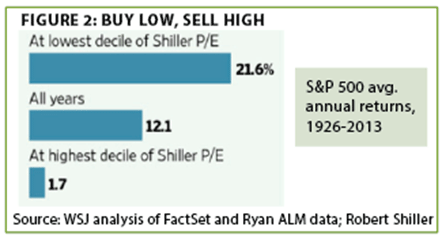
It also shocked and dismayed me at the time how many contortions Wall Street strategists, and even money managers, performed in order to dismiss concerns about the extreme variability of earnings. Somehow charts like the one below from Capital Economics were blown-off despite (or, perhaps, because) it so clearly highlighted the tendency of corporate profits to return back down to the long-term trend-line of nominal GDP growth, with stocks closely following. As we all now know, this time wasn’t different. (See Figure 3.)
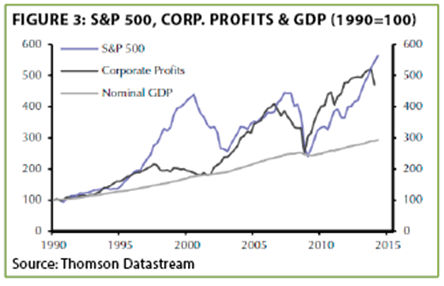
The legions of market cheerleaders also ignored the heavy reliance on profits from the financial sector, a notoriously unstable source of earnings. This proved to be a disaster in 2007 and, unsurprisingly, was again once the Fed’s “Great Levitation” fell victim to gravitational forces. (See Figure 4.)

Even David Rosenberg, one of the few economists who saw the housing debacle coming, but who briefly flirted with drinking the Fed-spiked bubble-aid in 2014, noted that 60% of earnings growth from 2010 through 2013 came from share buy-backs. He calculated that the market’s “organic” P/E, backing out the influence from share repurchases, was over 20, even prior to normalizing for peak profit margins. Additionally, the reality that corporations buy the most stock at high prices, and the least at low prices, was forgotten – another costly oversight. (See Figure 5, above.)
It was also overlooked during this era of Fed-induced euphoria, that low interest rates – so often cited by bulls as a justification for lofty P/Es – historically coincided with lower earnings multiples. (See Figure 6.)
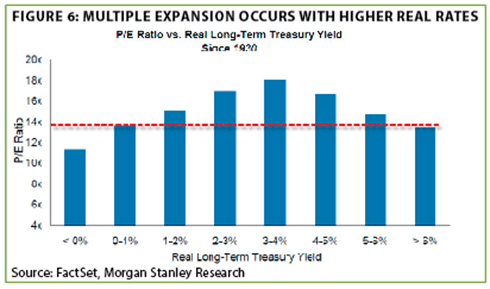
As Japan and Europe have repeatedly shown over the last two decades, when low interest rates are a function of chronic economic stagnation, P/Es actually contract, not expand. The fact that the latest recession has reduced America’s anemic 1.8% annual growth rate since 2000 to even lower levels is a key reason why stocks have been thrashed over the last couple of years, despite interest rates on the 10-year treasury note falling to 1%.
Another massive mistake was to overlook the strident warning from Evergreen’s favorite valuation metric, the price-to-sales (P/S) ratio. By the summer of 2014, the median stock in the S&P 500 was trading at its highest P/S ratio on record. Sadly, this attracted little attention. (See Figure 7.)
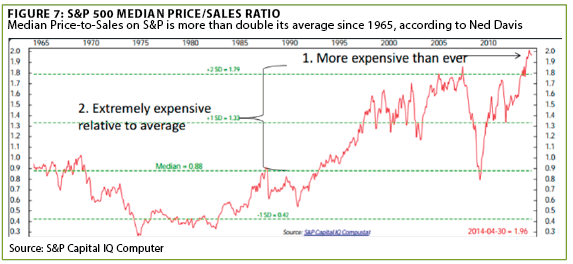
But perhaps the most egregious oversight of all was to forget the theorem from the late, great economist Hyman Minsky who long ago warned that stability breeds instability. As was the case from 2002 through 2007, the exceptionally low volatility of the years leading up to the latest crisis numbed market participants to the steadily rising risks. Even professional investors convinced themselves they could get out in time once conditions became unstable, an arrogance that has been severely punished, as well it should. Alas, we’ve had to learn Dr. Minsky’s lesson the hard way, once again.
But let’s close this EVA by focusing on the stunning opportunity for investors created by the Fed’s latest misadventure…
Investors, start your engines! It is certainly understandable that US investors are thoroughly disenchanted with the stock market. The fact that the powers-that-be, or at least used-to-be, allowed securities trading to become so heavily dominated by computers was, like the tolerance of the Fed’s asset inflation, inexcusable. The influence of computerized, black box trading was unquestionably a huge factor in the speed-of-light-in-a-vacuum drop in stock prices. Also as feared, many ETFs poured kerosene on the fire as investors became terrified by the nearly overnight erosion in these prices, causing them to sell en masse. The plethora of ETFs holding illiquid underlying securities were particularly crushed, with many simply halting trading for long stretches. Now, instead of rapturous paeans about the wonders of ETF liquidity and low costs, the financial press is full of horror stories about their fundamental flaws (fortunately, higher quality and more liquid ETFs, performed as expected during the worst of the panic).
Further, based on the failure of the Fed’s desperate maneuver to stabilize stocks after their first big break, by launching another $1 trillion QE, this time directly buying US shares, investors have rationally lost faith in the Fed’s ability to make stocks dance to its tune. While QE 4 did cause a sharp counter-trend rally after it was initially launched, the supportive effects soon waned, as we all are now painfully aware. The resumption of the bear market after the Fed’s frantic triage effort was reminiscent of Dorothy, the Tinman, the Lion, and Toto discovering that behind the green curtain was a scared old man instead of The Wizard of Oz.
The extreme negativity by investors toward the stock market today is reflected in the high level of outflows being seen from equity mutual funds, including ETFs. Cash levels are high everywhere as institutional and retail investors, as well as corporations, have become excessively risk averse. This provides the rocket fuel for the next bull market which might just be much closer than almost everyone believes.
Rampant investor pessimism is also being manifested in the drop in the Shiller P/E to the mid-teens from 26 at the peak of the last bull romp. As a direct result, future returns on stocks are now projected by the aforementioned Jeremy Grantham and John Hussman to be in the low double digits over the next seven to ten years. Yet, no one seems interested. Even Warren Buffett’s ragingly bullish comments, which were considerably premature, are being attributed to the ramblings of a soon-to-be nonagenarian.
Naturally, I have considerable empathy for Mr. Buffett because, as usual, Evergreen was early to shift into bullish mode. We waited much longer than most people and actually did a fairly commendable job of cutting back into the Fed’s QE4 driven rally, after raising our equity exposure during the initial steep sell-off. But once stocks fell hard after that sugar-high wore off, we were guilty of our typical “premature accumulation syndrome.”
However, we did the same thing way back in October of 2008 when we published our client newsletter, “A Bull is Born” (and wrote a series of “buy the panic” EVAs), only to watch the market slide another 30%. Yet, buying when almost the entire world was in liquidation mode, much of it forced, in the fall of 2008 proved to be extremely lucrative over the next two years. We are convinced the same will be true following this latest episode of market mayhem.
From a longer-term standpoint, a perspective most investors seem unwilling to take given their still-fresh pain and suffering, conditions look highly encouraging. In addition to the previously described remedies our policy makers are belatedly adopting, many of the key positive trends the bulls used to justify over-the-top valuations for stocks back in 2014 are still in place. Admittedly, the enthusiasm got ahead of reality but the energy renaissance continues apace in the US, despite the well-publicized fracking problems. Re-shoring of manufacturing, which has been slower than the uber-optimists forecast, appears to be now accelerating. Relatedly, robotic adoption is rapidly spreading through the US industrial base, supporting Evergreen’s belief that re-shoring is a reality, not a fantasy. Yet, there’s even more to like.
Nanotechnology and solar power innovators continue to provide breathtaking breakthroughs. Today, nanotech is becoming as ubiquitous as the microprocessor was a decade ago. Meanwhile, solar power, thanks to miniaturization advances similar to Moore’s Law, has achieved “grid parity,” or even lower, in over a dozen US states. Power is becoming increasingly cheap and abundant and that’s terrific news for humanity.
Finally, and perhaps most significantly, we are far closer to achieving that wondrous, if slightly scary, state known as “singularity.” As most us now know, this means that humans are becoming one with computers. The proliferation of wearables has essentially elevated the intelligence of anyone who can afford to spend $150 for an iWatch or Google Glass, to the level of a supercomputer. We now take for granted being able to whisper a few instructions into our watches, like Dick Tracy, and have all the information of the Cloud at our disposal. (It may soon be feasible to actually have a computer implanted into our brains, possibly even curing Alzheimer’s.) Clearly, the implications for productivity are nearly limitless. Already, we are beginning to see this in the data and we believe we are in the very early innings of a true revolution – with no apologies to gloomsters like Northwestern University’s Robert Gordon who believed, and still do, that the era of radical innovation ended long ago.
One of the biggest challenges a professional investor faces is the tyranny of current prices. When they are relentlessly rising, as they were back in 2013 and 2014, clients extrapolate those indefinitely, and, for a long time, they are right to do so. The same thing happens on the downside in periods such as we are in right now. But rising markets always turn down and falling ones always turn up. Those are unquestionable facts. We are getting closer to the point where this bear goes back into its cave for a nice long nap while a powerful young bull is ready to bust out of the pen it’s been cooped up in for what seems like an eternity. Get out your checkbook – it’s time to bet on the bull!
Back to the here and now. A wise man once said that if you are going to predict that something will happen, don’t be so foolish as to say when it will happen. You may have noticed, I’ve followed that advice, perhaps to an irritating degree, mainly because I truly have no clue when our current bull market, already so long in the horns, will succumb.
It also goes without saying, but I will anyway, that the sequence and details of future financial events are almost certain to be dramatically different than what I’ve suggested in this EVA edition. However, I believe the broad outline is likely to be roughly along these lines, including my exceedingly optimistic long-term outlook for America.
It dawned on me as I wrote the section about tax, tort, healthcare, and regulatory reforms that many readers were probably thinking: “Not in my lifetime – and I’m only 50!” First, of all, let me say that I’m jealous you’re just 50. Second, it is highly unlikely stocks will remain in a long-term bull market, or even continue to hover at such generous valuations, unless our country makes some truly dramatic changes. It can’t remain business as usual, persistently avoiding essential reforms, relying almost totally on the Fed.
Believe me, I will be a bull again, and likely a very lonely one at that. But it’s going to take a combination of lower valuations and a serious makeover of how this country operates. We can do it and I’m convinced we will do it. Hopefully, I’ll be able to convince some of you the next time fear is on the rampage.

Like Outside the Box?
Sign up today and get each new issue delivered free to your inbox.
It's your opportunity to get the news John Mauldin thinks matters most to your finances.
John Mauldin Archive |
© 2005-2022 http://www.MarketOracle.co.uk - The Market Oracle is a FREE Daily Financial Markets Analysis & Forecasting online publication.



